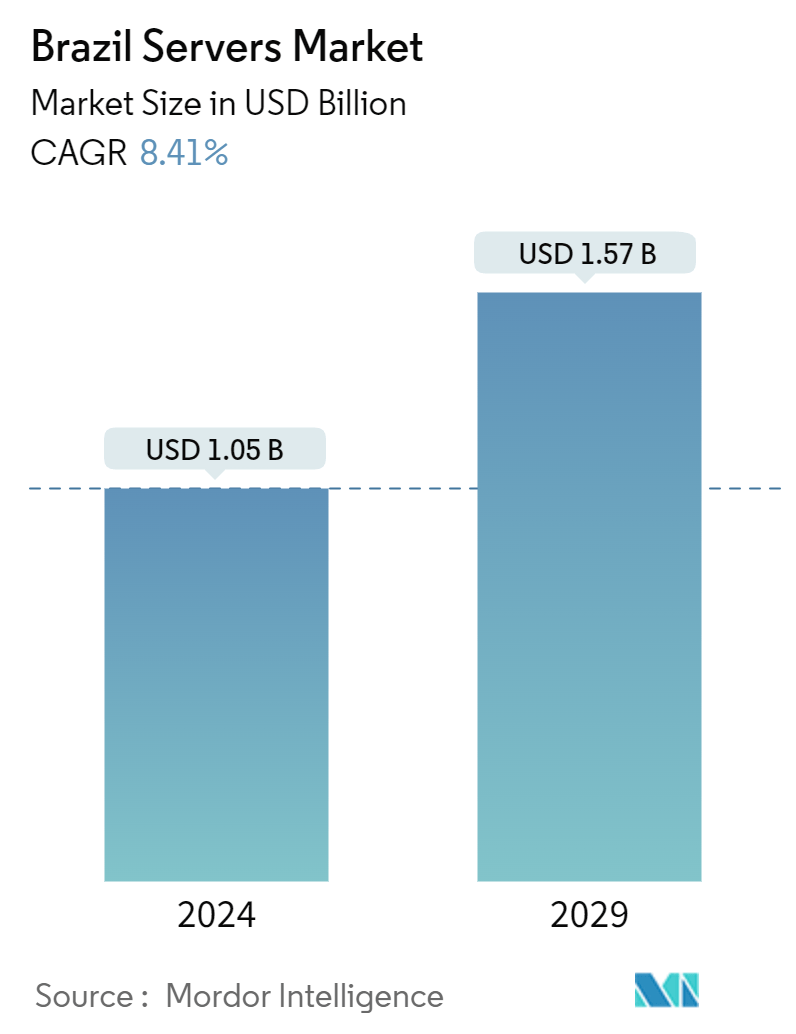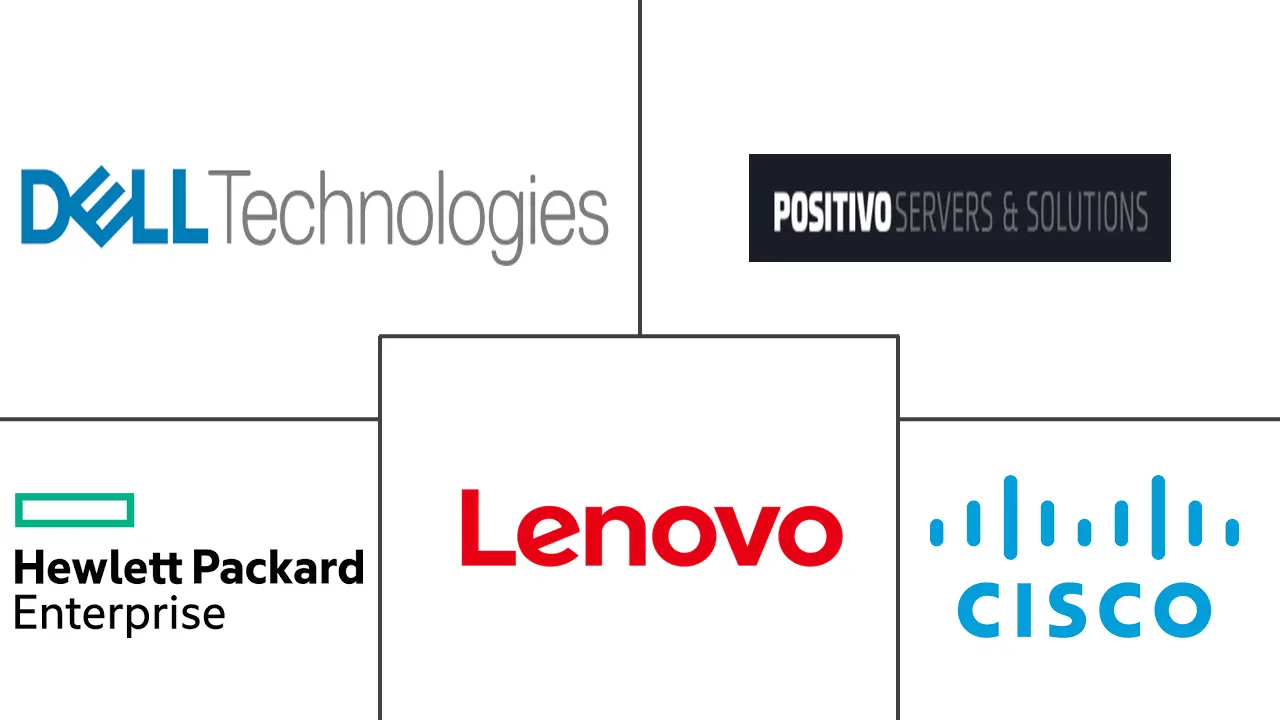Market Size of Brazil Servers Industry

| Study Period | 2019 - 2029 |
| Base Year For Estimation | 2023 |
| Market Size (2024) | USD 1.05 Billion |
| Market Size (2029) | USD 1.57 Billion |
| CAGR (2024 - 2029) | 8.41 % |
| Market Concentration | Low |
Major Players
*Disclaimer: Major Players sorted in no particular order |
Brazil Servers Market Analysis
The Brazil Servers Market size is estimated at USD 1.05 billion in 2024, and is expected to reach USD 1.57 billion by 2029, growing at a CAGR of 8.41% during the forecast period (2024-2029).
The growth of the Brazilian server market is driven primarily by digital transformation, cloud adoption, data center expansion, the Internet of Things (IoT), e-commerce growth, telecommunications infrastructure (rollout of 5G technology), artificial intelligence (AI), Big data, and government initiatives toward digitalization. These factors collectively contribute to the increasing demand for servers in the Brazilian market, driving domestic and international players to invest in server infrastructure to support the country's growing digital economy.
- In Brazil, the blockchain begins with cryptocurrency trading, primarily Bitcoin. Brazil actively explored blockchain technology to become a significant player in the global digital asset market, assisted by regulators such as the Central Bank and the Brazilian Securities and Exchange Commission. As a result, blockchain now extends beyond cryptocurrencies to various sectors, including agriculture, finance, logistics, and public administration.
- Disruptive technologies are pivotal for the success of FinTech startups in Brazil. Statistics reveal that artificial intelligence (AI) takes the lead, with 10% of these companies leveraging its capabilities. Big Data and APIs are each harnessed by 9% of startups. An equal 9% have embraced blockchain, emphasizing its role in securing and decentralizing data transfers.
- Server virtualization involves using software to partition a physical server into distinct, independent virtual servers. These virtual servers may each operate with their independent operating systems. While virtualization offers numerous benefits, its upfront costs may pose a significant challenge. The initial investment in virtualization software and hardware might be prohibitive for smaller enterprises. Yet, collaborating with managed service providers may mitigate these expenses.
- In Brazil, AI is revolutionizing medication discovery and clinical trials. AI algorithms sift through clinical trial data, aiming to unearth breakthrough treatments. This approach hastens drug discovery and enhances its efficacy. Brazil stands out as one of the swiftest expanding markets for healthcare AI.
- As of February 2024, Positivo, a Brazilian technology manufacturer, intended to increase investments in servers, processors, and high-performance machines to capture AI-leveraged business opportunities in Brazil and the Rest of Latin America.
Brazil Servers Industry Segmentation
A server is a computer system or software that provides services, data, or resources to other computers or clients over a network. Servers serve various functions, including hosting websites, managing emails, storing files, running applications, and handling databases. They are designed to manage, process, and respond to client requests efficiently and reliably.
The Brazilian servers market is segmented by operating system (Linux, Windows, UNIX, other operating systems ((i5/OS, z/OS, etc.)), server class (high-end server, mid-range server, and volume server), the server type (blade, multi-node, tower, and rack-optimized), and end-user industry (IT and telecommunications, BFSI, manufacturing, retail, healthcare, media and entertainment, and other end-user verticals). The report offers the market size in value terms in USD for all the abovementioned segments.
| By Operating System | |
| Linux | |
| Windows | |
| UNIX | |
| Other Operating Systems ((i5/OS, z/OS, etc.) |
| By Server Class | |
| High-end Server | |
| Mid-range Server | |
| Volume Server |
| By Server Type | |
| Blade | |
| Multi-node | |
| Tower | |
| Rack Optimized |
| By End-user Industry | |
| IT and Telecommunications | |
| BFSI | |
| Manufacturing | |
| Retail | |
| Healthcare | |
| Media and Entertainment | |
| Other End-user Verticals |
Brazil Servers Market Size Summary
The Brazilian servers market is experiencing significant growth, driven by factors such as digital transformation, cloud adoption, and the expansion of data centers. The increasing integration of technologies like the Internet of Things (IoT), artificial intelligence (AI), and big data, alongside government initiatives towards digitalization, are fueling the demand for servers. This growth is attracting both domestic and international players to invest in server infrastructure, supporting Brazil's burgeoning digital economy. The market is characterized by a competitive landscape with key players such as Hewlett Packard Enterprise Co., Dell Technologies Inc., Lenovo Group Limited, Cisco Systems Inc., and Positivo Tecnologia SA vying for market share.
In addition to traditional server applications, the Brazilian market is witnessing a surge in the adoption of disruptive technologies across various sectors. Blockchain technology, initially focused on cryptocurrency trading, is expanding into areas like agriculture, finance, and logistics. The telecommunications sector is also evolving, with significant investments in 5G infrastructure to enhance connectivity, particularly in rural areas. The software market is poised for growth, driven by the demand for security, data management, and customer experience solutions. The shift towards remote work, accelerated by the pandemic, is further propelling the adoption of cloud-based solutions, with Windows 10 and Office 365 playing a pivotal role in enhancing productivity and collaboration.
Brazil Servers Market Size - Table of Contents
-
1. MARKET INSIGHTS
-
1.1 Market Overview
-
1.2 Industry Attractiveness - Porter's Five Forces Analysis
-
1.2.1 Bargaining Power of Suppliers
-
1.2.2 Bargaining Power of Consumers
-
1.2.3 Threat of New Entrants
-
1.2.4 Threat of Substitute Products
-
1.2.5 Intensity of Competitive Rivalry
-
-
1.3 Industry Value Chain Analysis
-
1.4 Policy and Regulatory Landscape of Brazil
-
1.5 Impact on Tertiary Industry: Digitalization in Services PESTLE Analysis
-
-
2. MARKET SEGMENTATION
-
2.1 By Operating System
-
2.1.1 Linux
-
2.1.2 Windows
-
2.1.3 UNIX
-
2.1.4 Other Operating Systems ((i5/OS, z/OS, etc.)
-
-
2.2 By Server Class
-
2.2.1 High-end Server
-
2.2.2 Mid-range Server
-
2.2.3 Volume Server
-
-
2.3 By Server Type
-
2.3.1 Blade
-
2.3.2 Multi-node
-
2.3.3 Tower
-
2.3.4 Rack Optimized
-
-
2.4 By End-user Industry
-
2.4.1 IT and Telecommunications
-
2.4.2 BFSI
-
2.4.3 Manufacturing
-
2.4.4 Retail
-
2.4.5 Healthcare
-
2.4.6 Media and Entertainment
-
2.4.7 Other End-user Verticals
-
-
Brazil Servers Market Size FAQs
How big is the Brazil Servers Market?
The Brazil Servers Market size is expected to reach USD 1.05 billion in 2024 and grow at a CAGR of 8.41% to reach USD 1.57 billion by 2029.
What is the current Brazil Servers Market size?
In 2024, the Brazil Servers Market size is expected to reach USD 1.05 billion.

